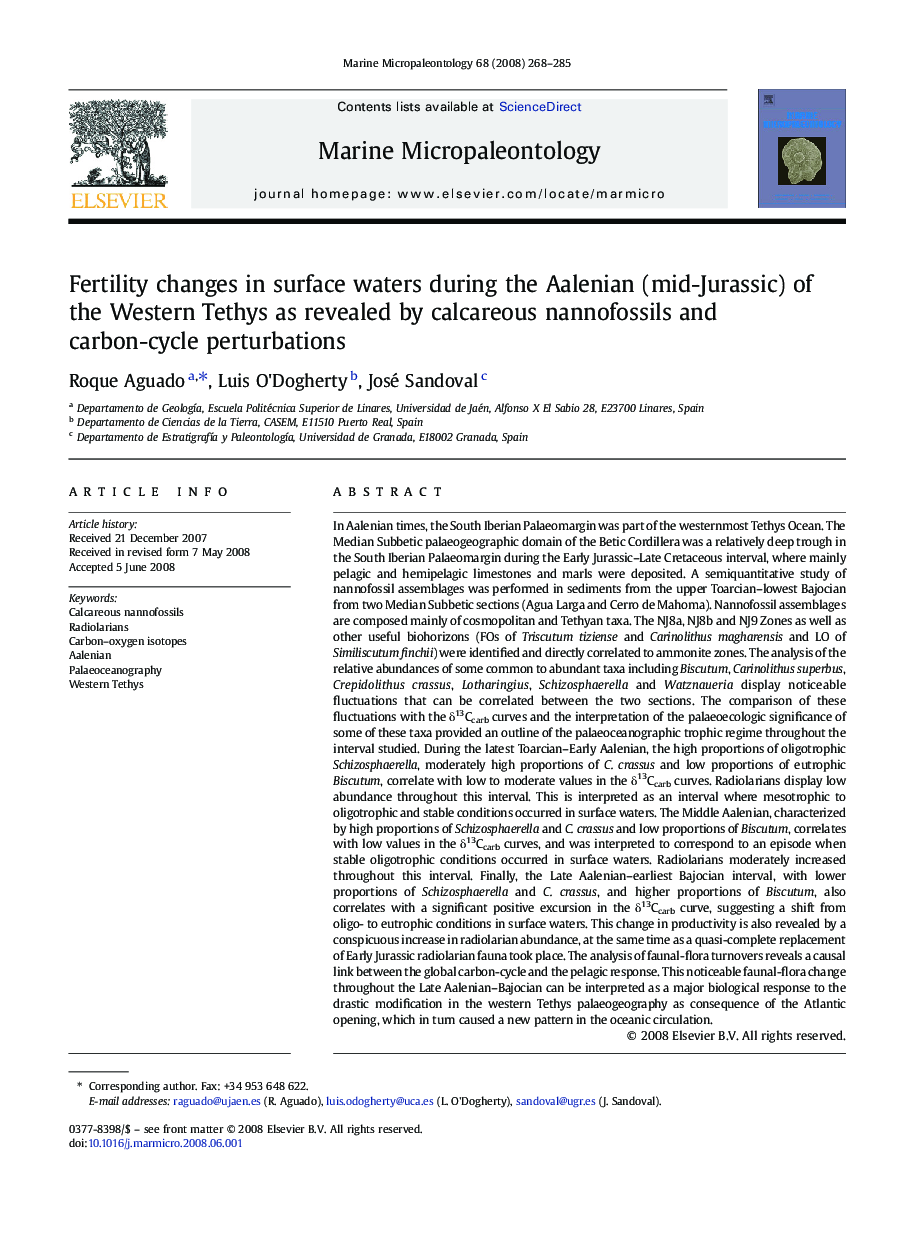| کد مقاله | کد نشریه | سال انتشار | مقاله انگلیسی | نسخه تمام متن |
|---|---|---|---|---|
| 4749238 | 1642220 | 2008 | 18 صفحه PDF | دانلود رایگان |

In Aalenian times, the South Iberian Palaeomargin was part of the westernmost Tethys Ocean. The Median Subbetic palaeogeographic domain of the Betic Cordillera was a relatively deep trough in the South Iberian Palaeomargin during the Early Jurassic–Late Cretaceous interval, where mainly pelagic and hemipelagic limestones and marls were deposited. A semiquantitative study of nannofossil assemblages was performed in sediments from the upper Toarcian–lowest Bajocian from two Median Subbetic sections (Agua Larga and Cerro de Mahoma). Nannofossil assemblages are composed mainly of cosmopolitan and Tethyan taxa. The NJ8a, NJ8b and NJ9 Zones as well as other useful biohorizons (FOs of Triscutum tiziense and Carinolithus magharensis and LO of Similiscutum finchii) were identified and directly correlated to ammonite zones. The analysis of the relative abundances of some common to abundant taxa including Biscutum, Carinolithus superbus, Crepidolithus crassus, Lotharingius, Schizosphaerella and Watznaueria display noticeable fluctuations that can be correlated between the two sections. The comparison of these fluctuations with the δ13Ccarb curves and the interpretation of the palaeoecologic significance of some of these taxa provided an outline of the palaeoceanographic trophic regime throughout the interval studied. During the latest Toarcian–Early Aalenian, the high proportions of oligotrophic Schizosphaerella, moderately high proportions of C. crassus and low proportions of eutrophic Biscutum, correlate with low to moderate values in the δ13Ccarb curves. Radiolarians display low abundance throughout this interval. This is interpreted as an interval where mesotrophic to oligotrophic and stable conditions occurred in surface waters. The Middle Aalenian, characterized by high proportions of Schizosphaerella and C. crassus and low proportions of Biscutum, correlates with low values in the δ13Ccarb curves, and was interpreted to correspond to an episode when stable oligotrophic conditions occurred in surface waters. Radiolarians moderately increased throughout this interval. Finally, the Late Aalenian–earliest Bajocian interval, with lower proportions of Schizosphaerella and C. crassus, and higher proportions of Biscutum, also correlates with a significant positive excursion in the δ13Ccarb curve, suggesting a shift from oligo- to eutrophic conditions in surface waters. This change in productivity is also revealed by a conspicuous increase in radiolarian abundance, at the same time as a quasi-complete replacement of Early Jurassic radiolarian fauna took place. The analysis of faunal-flora turnovers reveals a causal link between the global carbon-cycle and the pelagic response. This noticeable faunal-flora change throughout the Late Aalenian–Bajocian can be interpreted as a major biological response to the drastic modification in the western Tethys palaeogeography as consequence of the Atlantic opening, which in turn caused a new pattern in the oceanic circulation.
Journal: Marine Micropaleontology - Volume 68, Issues 3–4, August 2008, Pages 268–285